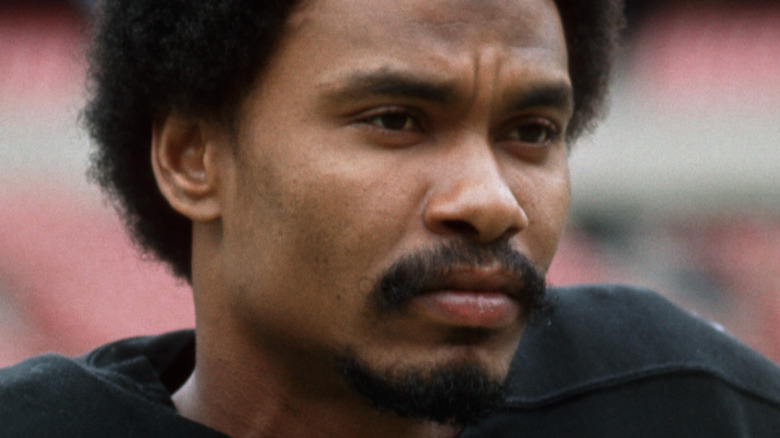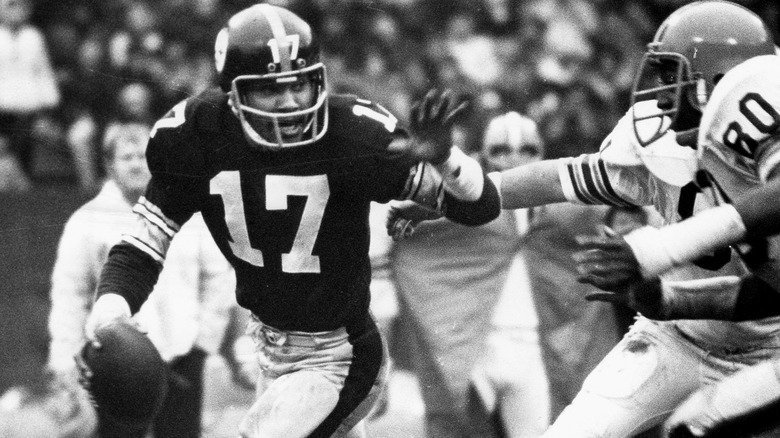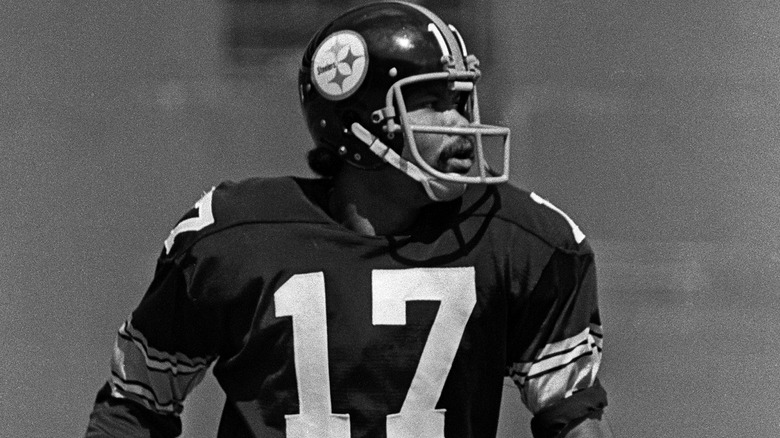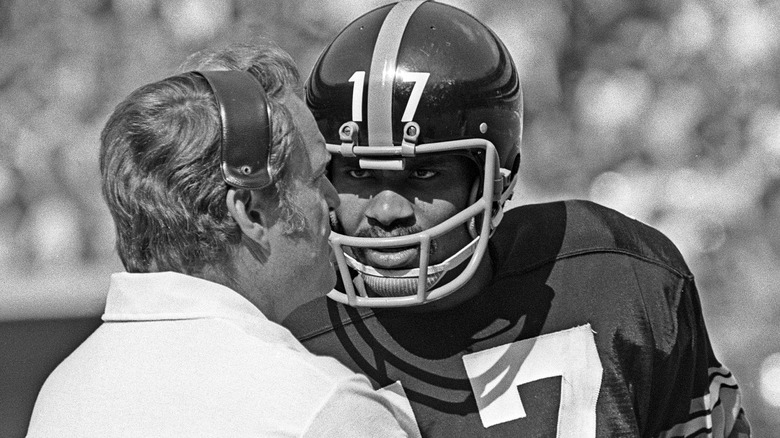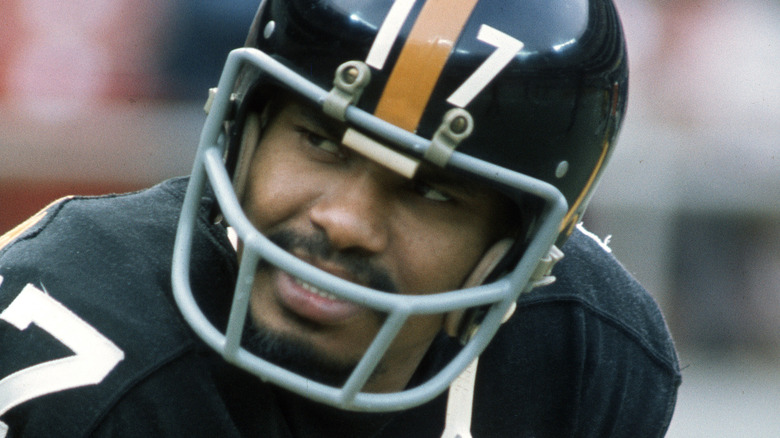The Tragic Career Of Joe Gilliam, The NFL's First Opening Day Black Starting Quarterback
Simply put, the Pittsburgh Steelers teams of the 1970s were stacked on both sides of the ball. On offense, they had a talented, charismatic quarterback in Terry Bradshaw, who regularly connected with wide receivers John Stallworth and Lynn Swann when he wasn't handing the ball off to running backs Franco Harris and Rocky Bleier. The late Mike Webster became the gold standard for NFL centers as he anchored the Steelers' offensive line, which provided Bradshaw with ample protection and opened up a lot of holes for the backfield. On the other side of things, the Steelers were known for their "Steel Curtain" defense, which featured defensive tackle "Mean" Joe Greene and linebackers Jack Lambert and Jack Ham, among others.
Often forgotten among all those iconic Super Bowl-winning individuals is quarterback Joe Gilliam, who mostly served as a backup to Bradshaw in his four-year NFL career. Nicknamed "Jefferson Street Joe" for a street in his hometown of Nashville and as a nod to the New York Jets' star QB "Broadway" Joe Namath (via Andscape), Gilliam's time in the NFL was brief. However, there was a moment when he seemed like the league's next big thing. In 1974, he wasn't just emerging as a potential star quarterback on a team that already had one — Gilliam was also writing his name on the NFL record books as the league's first-ever Black quarterback to start on opening day.
Gilliam spent his first two NFL seasons as a backup to a Hall of Famer
A star quarterback for Tennessee State, Joe Gilliam lasted all the way till the 11th round of the 1972 NFL Draft (via Pro Football Reference), where he was selected by the Pittsburgh Steelers, a team that already had a skillful young signal-caller in 1970's top pick, Terry Bradshaw. With another highly regarded youngster with the same first name (former Heisman Trophy candidate Terry Hanratty) already backing up the future Hall of Famer, Gilliam seemed destined to hold the clipboard for much of his rookie season. That is until an injury to Hanratty forced the Steelers to activate Gilliam midway through the 1972 campaign, per The Cincinnati Enquirer.
Gilliam didn't do much as a rookie, completing seven out of his 11 passes in two games. During his sophomore campaign, the former Tennessee State standout got more playing time, but his numbers left a lot to be desired — he had a completion rate of only 33.3% (20 completions in 60 attempts) and threw only two touchdowns to six interceptions. Such figures don't exactly bode well for one's chances to earn a regular starting job. But that's exactly what Gilliam got at the start of the 1974 NFL season, as he surprisingly dislodged Bradshaw from his spot on the depth chart as Pittsburgh's No. 1 QB.
He achieved a historic first for Black NFL quarterbacks
Technically speaking, James Harris was the first Black quarterback to start on opening day when he did so for the Buffalo Bills in 1969 (via Fox Sports). However, the Bills were then part of the American Football League (AFL), whose merger with the NFL would take effect the following season. As such, it wasn't until 1974 that the NFL celebrated the same milestone as Joe Gilliam took the field as the Pittsburgh Steelers' opening-day starting quarterback. As it turned out, Gilliam really impressed head coach Chuck Noll during the preseason, playing well enough to overtake Terry Bradshaw and Terry Hanratty on the depth chart.
It's been alleged that Gilliam was only able to win the No. 1 QB job over Bradshaw because he crossed picket lines while the would-be Steelers legend and other veteran teammates were on strike. This was, however, refuted in 2011 by filmmaker Dexter Rogers, who was then working on a documentary about Gilliam's life. In a piece he wrote for Bleacher Report, Rogers maintained that Gilliam became the top guy behind center because he was simply the better player and noted that Bradshaw himself admitted multiple times that Gilliam outplayed him in the preseason.
At first, it seemed Noll made the right call, as Gilliam had a sensational start to the 1974 season, throwing two touchdown passes and completing 17 of his 31 pass attempts for 257 yards as Pittsburgh blanked the Baltimore Colts, 30-0 (per Steelers.com). So impressive was Gilliam's performance that he was featured as Sports Illustrated's cover athlete for its September 23, 1974 issue. Everything seemed to be coming up roses for the young signal-caller, but the good times, unfortunately, weren't meant to last.
A dizzying fall from grace in the same season
Joe Gilliam had another big game in Week 2 of the 1974 NFL season as the Pittsburgh Steelers and Denver Broncos fought to a 35-all tie. Per Pro Football Reference, he threw for only one touchdown to two interceptions, but he still finished 31-for-50 with 348 passing yards. But Gilliam wasn't able to sustain his fast start, and in Week 3, he completed just eight out of 31 passes and threw two picks as the Steelers were trounced by the Oakland Raiders, 17-0.
The Steelers won their next three games, but Chuck Noll had seen enough at that point; the legendary coach demoted Gilliam after yet another poor showing against the Cleveland Browns (via Sports Illustrated). Gilliam finished the 1974 campaign with four touchdown passes and eight interceptions, a 45.3% completion percentage, and a 55.4 QB rating. As for Bradshaw, he reclaimed the No. 1 QB role and led the Steelers to their first-ever Super Bowl win that season.
After spending the 1975 season as a backup, the Steelers waived Gilliam in June 1976 for missing multiple team meetings (via the Pittsburgh Post-Gazette), wrapping up his brief NFL career. Commenting on his decision to release Gilliam, Noll told Sports Illustrated that his one-time opening-day starter had become unreliable. "He was of no use to the team," he continued. "We couldn't depend on him, and there was nothing else to do with a player like that other than to let him go."
Gilliam dealt with substance abuse for much of his adult life
Life wasn't always easy for African American quarterbacks in the 1970s, and this was tragically the case with Joe Gilliam. In his Bleacher Report piece, Dexter Rogers wrote that his documentary on Gilliam cited the signal-caller as saying that he started taking drugs after he performed poorly in the aforementioned 1974 game against the Oakland Raiders. Not helping matters were the death threats he constantly received from racist fans. "I guess it was my way of not facing and dealing with the fact that I wasn't playing for the Steelers," Gilliam recalled to Sports Illustrated. "It was my way of hiding from what was really happening and not facing up to things," he later added.
After the NFL, Gilliam frequently found himself in trouble with the law and racked up a number of drug-related arrests, according to Andscape. When Bob Costas spoke to him in 1996 for a Super Bowl XXX segment, he was homeless, albeit drug-free for some time, as he claimed. Things seemed to be looking up for Gilliam a few years later as he opened his own football camp at his alma mater, Tennessee State. But on December 25, 2000, just four days before his 50th birthday, Gilliam died of an accidental cocaine overdose.
"He gave the NFL a breakthrough," Gilliam's best friend and former high school and college teammate, Howard Gentry, told Andscape. "He let the NFL know that Black quarterbacks could not only play, but they could play at a high level. We lost a pioneer way too soon."
If you or anyone you know needs help with addiction issues, help is available. Visit the Substance Abuse and Mental Health Services Administration website or contact SAMHSA's National Helpline at 1-800-662-HELP (4357).
